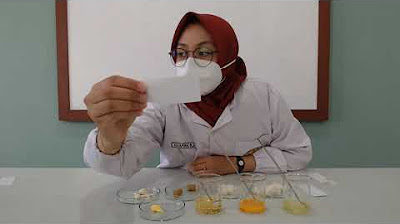PRAKTIKUM UJI ZAT MAKANAN - LABORATORIUM BIOLOGI SMA N 1 SOKARAJA
Summary
TLDRThis video tutorial guides viewers through a practical food nutrient testing experiment, demonstrating how to test for starch, protein, glucose, and fat in various food samples. It covers essential tools, materials, and step-by-step procedures for each test, explaining how to identify the presence of nutrients based on color changes. The video emphasizes safety while handling chemicals and heated equipment, and highlights the importance of recording observations for accurate results. Aimed at helping students understand food chemistry, the tutorial provides a clear and engaging introduction to basic nutrient analysis in foods.
Takeaways
- 😀 The video introduces a food substance testing practical, detailing necessary equipment and chemicals.
- 😀 The testing involves determining whether food contains starch, protein, glucose, and fat using specific reagents and procedures.
- 😀 The equipment includes porcelain dishes, test tubes, stirrers, and a spirit burner, essential for conducting the experiments.
- 😀 Lugol's solution is used to test for starch by adding 5-10 drops to the food sample, where a color change to dark blue indicates the presence of starch.
- 😀 To test for protein, a biuret reagent is added, and a purple color change signifies the presence of protein due to a reaction between NaOH and CuSO4.
- 😀 Glucose testing involves crushing the food sample, adding aquadest, and using Benedict’s solution. A color change to orange or red after heating indicates glucose.
- 😀 Fat testing is performed by rubbing the food on filter paper and checking for transparency, which would suggest the presence of fats.
- 😀 The video emphasizes the importance of following precise steps, such as using the correct amounts of reagents and heating the samples properly.
- 😀 Safety precautions are crucial during the experiment, especially when handling heated equipment and chemicals.
- 😀 The experiment also highlights the necessity of recording results accurately during the testing process to analyze the presence of various food substances.
Q & A
What is the primary focus of the video?
-The video focuses on demonstrating how to conduct practical tests to identify the presence of starch, protein, glucose, and fat in various food samples.
What are the key tools and materials mentioned in the video for the experiments?
-The video mentions tools like porcelain dishes, test tubes, stirring rods, and materials like Lugol's iodine solution, Biuret reagent, Benedict's solution, aquadest, and blotting paper.
What is the purpose of the Lugol's iodine solution in the starch test?
-Lugol's iodine solution is used in the starch test to detect the presence of starch in food. If starch is present, the solution will turn blue-black.
How can you tell if a food sample contains protein?
-To test for protein, add Biuret reagent to the crushed food sample. If protein is present, the solution will turn purple due to a chemical reaction between NaOH and CuSO4.
What is the purpose of Benedict's reagent in the glucose test?
-Benedict's reagent is used to test for the presence of glucose. When mixed with a food sample and heated, a color change to red or orange indicates the presence of glucose.
What does a color change to blue-black indicate in the starch test?
-A blue-black color change in the starch test indicates that the food sample contains starch.
What should you do if the test tube or equipment gets too hot during the experiments?
-Always handle heated test tubes and equipment with care to avoid burns or accidents. It is important to follow safety precautions while performing the experiments.
How can you test for the presence of fat in a food sample?
-To test for fat, place a small amount of the food sample on blotting paper. If the paper becomes translucent, it indicates that the food contains fat.
What safety precautions should be taken during the practical tests?
-Safety precautions include carefully handling heated test tubes, ensuring thorough mixing of reagents, and being cautious with chemicals like NaOH and CuSO4, as well as with the spirit lamp used for heating.
What role does aquadest play in the glucose test?
-Aquadest (distilled water) is used to dilute the food sample before adding Benedict's reagent in the glucose test, ensuring that the reaction occurs properly when the mixture is heated.
Outlines

Cette section est réservée aux utilisateurs payants. Améliorez votre compte pour accéder à cette section.
Améliorer maintenantMindmap

Cette section est réservée aux utilisateurs payants. Améliorez votre compte pour accéder à cette section.
Améliorer maintenantKeywords

Cette section est réservée aux utilisateurs payants. Améliorez votre compte pour accéder à cette section.
Améliorer maintenantHighlights

Cette section est réservée aux utilisateurs payants. Améliorez votre compte pour accéder à cette section.
Améliorer maintenantTranscripts

Cette section est réservée aux utilisateurs payants. Améliorez votre compte pour accéder à cette section.
Améliorer maintenantVoir Plus de Vidéos Connexes

UJI MAKANAN (Amilum, Glukosa, Protein, dan Lemak) || Praktikum Biologi

Uji Bahan Makanan

Praktikum Uji Makanan - Bu Shafira Ramadhanty Adityaningsih

Pearson Edexcel GCSE Biology Core Practical - testing for starch, reducing sugars, protein and fats

Praktikum Uji Makanan Biologi Kelas XI

Test for Carbohydrates, Proteins and Fats - MeitY OLabs
5.0 / 5 (0 votes)
